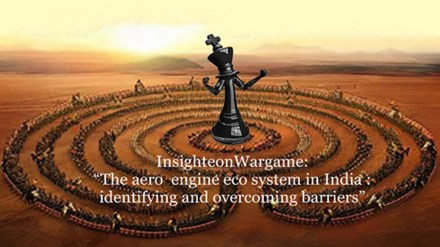Smaller, more numerous, and effective weapons systems are being developed as a result of changes in the nature of combat. Nearly all forms of weapon systems exhibit this tendency, with aerial combat experiencing the most drastic transformation with the introduction of AI-enabled Unmanned Aerial Vehicles.
Work has already begun at HAL on its three distinct aspects – the CATS Warrior (a teaming drone), the CATS Hunter (an air-launched cruise missile), and the Alpha-S (a glider drone). These unmanned systems are all equipped with electro-optical and infrared sensors.
To this effect with the aim of ascertaining a roadmap for the development of an aero engine ecosystem in India, an interactive war-game between August 23-25 was held.
Insighteon Consulting undertook this initiative and it saw participation by retired Defence Research and Development Organisation senior scientists, academia, retired defence officers, bureaucrats, diplomats and members of various think tanks. Key public sector players also joined in including the likes of ISRO, Hindustan Aeronautics, National Aerospace Laboratories, Gas Turbine Research Establishment and private sector firms like Godrej Aerospace, Paninian India and Bharat Forge also were part of this.
Also Read: EY-FICCI report estimate drone industry to boost India’s manufacturing potential to $23 billion by 2030
Some of the key takeaways include-
-The creation of domestic aero engines is strategic. Future military strategic challenges are made even more urgent by the growing demand and variety of uses for aero engines brought on by the increased use of UAVs and low-cost cruise missiles. India has no option but to develop its own aero engines as well as establish resilient supply chains for the products. By not indigenising aero engines, India runs a huge risk of compromising national security.
-The defence ministry will save Rs 3 lakh crore with indigenised gas turbine engines over a 20-year period.
-India will be investing more of its defence budget in unmanned aerial vehicles and low-cost cruise missiles, which will complement more and more activities in military operations.
-The market for small engines is anticipated to generate Rs 61,000 crores over the next 20 years.
The experts further highlighted that as a first step, India needs to put restrictions on itself on import of small aero engines and add it to the “positive list ofindigenisation”.
A new module titled National Commission for Aero Engine Development (NCAED) was suggested.The analysts recommended that design and development as well as production should come under one head at the top level, to have a seamless coordinated development programme which allows cross pollination of technologies and prevents duplication of effort.
